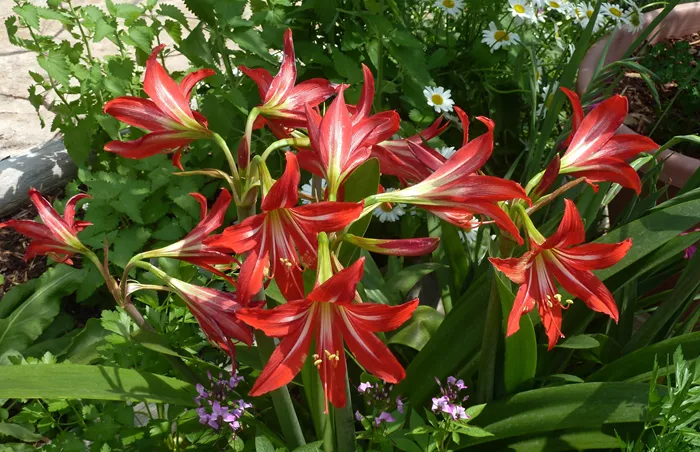Amaryllis flowers are known for their stunning blooms, which can brighten up any home. However, many people aren’t sure how to care for their amaryllis once it has finished flowering. The good news is that amaryllis plants are relatively easy to care for after their bloom, and with the right attention, they can bloom again next year. In this article, we’ll walk you through the best practices for caring for your amaryllis after it flowers, ensuring it stays healthy and vibrant for the next season.
Proper aftercare is essential for your amaryllis plant to thrive and bloom again in the future. By following simple steps like managing watering, sunlight, and fertilizing, you can give your plant the best chance for a long life and repeated blooms. Let’s dive into the detailed steps you can take to care for your amaryllis after flowering.
How To Care For Amaryllis After Flowering?
1. Allow the Leaves to Stay
After the flowers fade, you might be tempted to cut the plant back. However, it’s best to leave the green leaves alone. These leaves are vital as they help the bulb store energy for the next flowering season. Just like other plants, amaryllis needs its foliage to photosynthesize and gather energy from sunlight.
Continue watering the plant as usual, making sure the soil is moist but not soggy. Keep it in a spot that gets plenty of indirect sunlight. If you cut back the leaves prematurely, you may weaken the bulb and reduce the chances of a successful bloom next year.
2. Reduce Watering Gradually
After the bloom, the plant enters a slower growth phase. You should start to reduce watering gradually. The goal is to allow the soil to dry out a little more between waterings. This signals the plant to enter a resting phase.
Avoid letting the soil dry out completely, but do not keep it too moist either. By adjusting watering practices, you encourage the plant to rest, which is important for its next cycle of growth. Reducing water too suddenly may stress the plant, so be gradual.
3. Stop Fertilizing After Flowering
While the amaryllis is growing actively, it benefits from regular feeding. However, once the flowers fade and the plant enters a resting period, you should stop fertilizing. Excess nutrients during this dormant phase can cause the plant to grow too much foliage at the expense of energy storage.
Resume feeding the amaryllis only after the resting phase is over and the plant begins to show signs of new growth. When you begin feeding again, use a balanced liquid fertilizer to support the plant as it begins to sprout new shoots.
4. Move the Plant to a Cooler Spot
Amaryllis goes dormant after flowering, and it’s important to create the right environment for it to rest. This can be achieved by moving your plant to a cooler, dry location. Typically, a temperature range of 50–60°F (10–15°C) is ideal during the dormancy period.
Avoid placing it in a drafty spot or exposing it to direct sunlight. It’s important to let the plant rest without being disturbed by excessive heat or light. This period usually lasts around 6–8 weeks, so patience is key.
5. Repot If Necessary
If you notice that the pot is becoming too small for your amaryllis bulb or that the soil is no longer draining well, it may be time to repot your plant. Choose a pot that is 1–2 inches larger in diameter than the current one. Amaryllis bulbs like to be snug in their pots, so avoid choosing a pot that is too large.
Repotting should be done before the plant comes out of its dormant phase. Use fresh potting mix with good drainage, and gently place the bulb back into the pot. Be careful not to damage the roots while repotting.
6. Prepare for Blooming Next Season
Once the dormancy period is over, the bulb will start to sprout new growth. At this point, you can start watering the plant again and place it in a warm location with plenty of indirect sunlight.
It may take a few weeks for the stalk to emerge, but soon enough, you’ll see the first signs of a new bloom. With proper care during its resting period, your amaryllis should reward you with another round of stunning flowers.
7. Common Mistakes to Avoid
Amaryllis care is relatively simple, but there are a few common mistakes to avoid. One of the biggest mistakes is overwatering during the dormant period, which can lead to bulb rot. Always let the soil dry out slightly before watering again.
Another mistake is failing to provide the plant with a proper dormancy period. If you skip this phase or don’t give the bulb enough time to rest, you may not see flowers next season. Lastly, make sure the plant is getting the right amount of sunlight during its growing period, as insufficient light can lead to weak growth.
FAQs About Amaryllis Flowers
How do I know when my amaryllis needs to rest?
After the flowers fade, the plant will naturally begin to slow down. The leaves will start to yellow and die off. This is a sign that the amaryllis is preparing for its dormant period. During this time, it’s essential to reduce watering and stop fertilizing.
Can I force my amaryllis to bloom again sooner?
Yes, you can “force” amaryllis to bloom sooner by manipulating its dormancy period. If you want the plant to bloom for a specific occasion, like the holidays, you can shorten the dormancy phase and start the watering and sunlight process earlier.
What should I do if my amaryllis bulb doesn’t bloom?
If your amaryllis doesn’t bloom, it could be due to a few reasons, such as insufficient sunlight or an inadequate dormancy period. Make sure to follow the care guidelines carefully, particularly the resting phase, and give the plant enough time and light to trigger the bloom.


